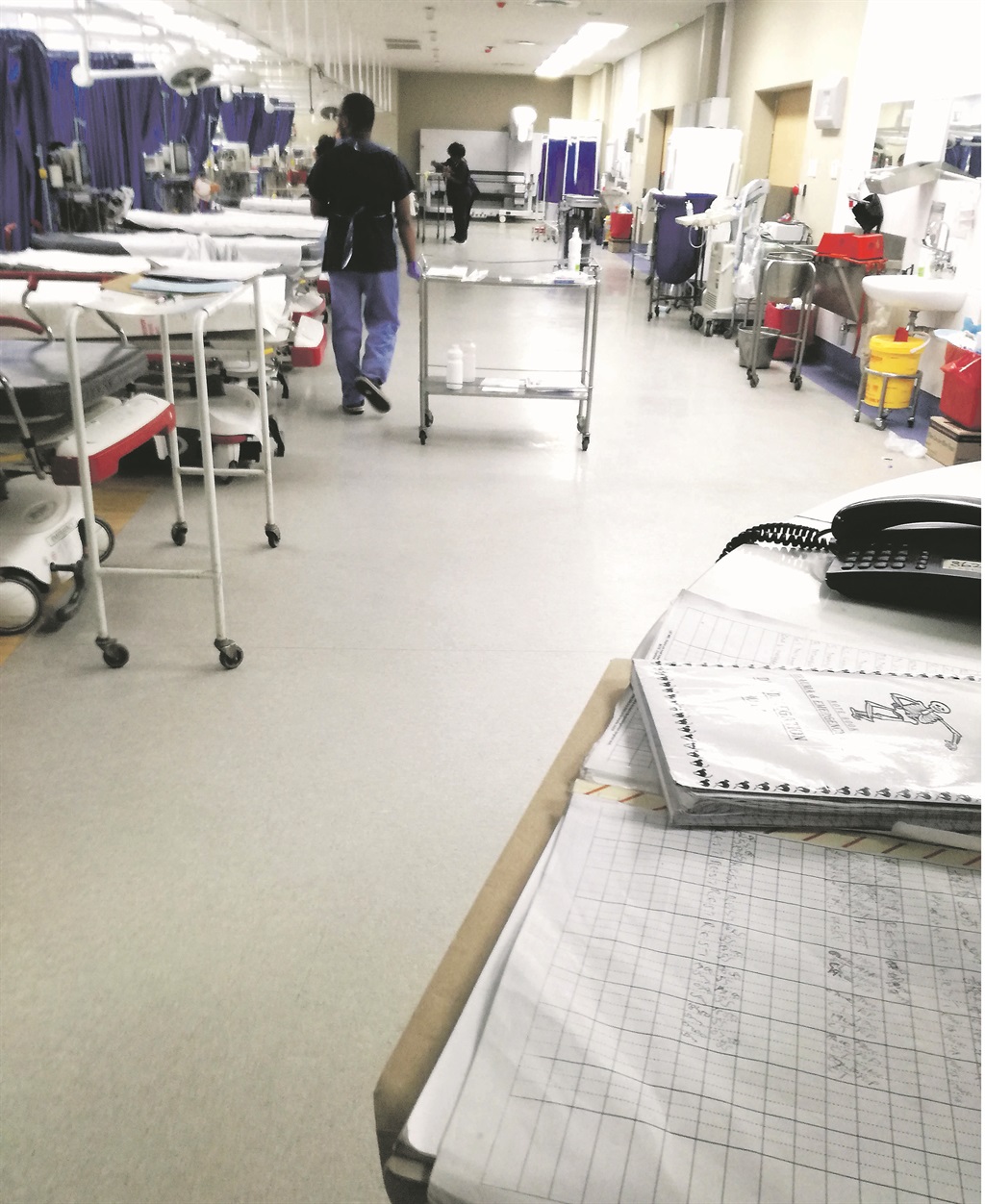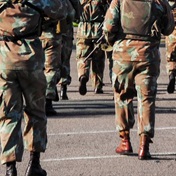
As the festive season kicks in, accidents and domestic violence reach an often alcohol-induced fever pitch. Vuyo Mkize spent a night at Bara, the world’s third-largest hospital. Here’s what went down:
The night starts off with ominous greyish-brown clouds.
Sharp stabs of lightning periodically pierce through the gloomy sky as gusts of wind send tree branches sashaying into the air.
Dr Shaun Marion, a senior registrar at the Chris Hani Baragwanath Academic Hospital’s medical emergency ward, briskly takes me through the rules for the night: “Respect doctor-patient confidentiality”.
The hospital has the third-largest emergency trauma unit in the world and services patients not only from Soweto, but also from neighbouring provinces.
Recently an image showing the hospital’s crowded trauma and resuscitation unit after a “chaotic weekend” – with splatters of blood, foil and pieces of clothing strewn on the floor – raised social media ire when it was shared widely on Twitter.
The hospital was at pains to explain that the ward was in that state after doctors and nurses worked hard to save lives.
The hospital staff are the first to admit that they are stretched.
It is bad most weekends but, as the festive season kicks into gear, doctors and nurses expect an influx of patients coming in with serious injuries from car crashes and stab wounds to brawls or assault.
They know too that it gets worse with each passing December weekend.
It’s 6.42pm on Friday night, December 14, and all still seems relatively “quiet”.
Some patients are sitting quietly on the unit’s benches, others with breathing problems are being monitored closely by nurses at the medical emergency resuscitation room.
Marion says there are generally four interns, three junior registrars, two senior registrars and a consultant trauma surgeon on shift at the emergency trauma unit, and four to five doctors a shift on the medical emergency side.
“What you’re going to see from tomorrow [Saturday] is that this whole place will be full, patients will be on the floor and the ICU will be full … most of it is alcohol-related incidents, some are from stabbings and accidents,” Marion says.
Walking into the unit there are 10 beds with white hospital linen. The beds line the room.
At the far end lies an unconscious toddler with red lateral boards on either side of his head – he had been stabilised earlier.
The rest of the beds are still empty – but not for long.
IT STARTS
A woman – seemingly in her early to mid-30s – is quickly wheeled in with visible head injuries and bleeding around her face and head, which is supported by a neck brace.
Nurses and doctors scurry towards her. Her torn clothing is cut with scissors revealing her naked body as the team desperately tries to resuscitate her. She was found injured on the side of a road.
“Are the lines in? Suction! Suction!,” shouts out Dr Nhloso Dlomo, a senior registrar who is normally stationed at the theatre, but who helps when there is a serious resuscitation.
Moments later, by 7.47pm, a second patient, covered in foil, is wheeled in by paramedics.
“Four P1s from ER24 are on the way,” Dlomo shouts out to the doctors and nurses in the room.
“I’m serious. Do what you need to do, drink what you need to drink now, sekuzo shuba,” he warns half jokingly and half seriously.
P1 patients, as a nurse, who asks to remain anonymous, says, are the critically injured or ill patients.
Patients are categorised as P1, P2 and P3.
P3s are not so serious and can usually be seen at a district level hospital, such as Bheki Mlangeni Hospital in Jabulani, Soweto.
“These [P1 and P2] are the patients for Bara, not walk-ins,” the nurse says, pointing to the critically ill patient on the stretcher being worked on by doctors and her colleagues.
FULL PICTURE
“The community must get the full picture. We get very bad cases. They have been shot, hit by cars, everything. You see us coming in siphapha, oooh! Give us an hour – one nurse. We don’t sleep,” the senior nurse says.
Marion agrees, saying it is usually pretty quiet until about midnight: “The flood gates open, a lot of life- threatening injuries and illnesses come in.”
But on this night, one doesn’t have to wait until midnight to see the pressure the doctors and nurses face. By 8.09pm there are four critical patients.
“They [ambulances] bring everyone here, that’s the problem and there are just too few of us,” a nurse says.
Eight minutes later another patient is hurriedly wheeled in.
“Ithomile iresus [the business has begun at the unit], early,” a nurse says, almost exasperatedly.
A family member walks hesitantly into the resuscitation unit, but is quickly taken away by the nurse and is asked to wait outside.
“Logroll on the count of three – did you check the spine?” Dlomo asks his team of about five other practitioners working on one patient.
A red light starts flashing on a monitor, it goes quiet again. A few minutes later, he announces that he is happy with the progress of the woman who first came in, she is stabilised and her lungs look fine.
By 9.10pm the ward is relatively calm as staff continue working on the patients already there.
In between all this, doctors have to make notes on the work they perform on each patient. “That’s the great thing about [the] private [sector],” Dlomo says, looking tired, “someone writes notes for you.”
The assistant head nurse says they try to divide tasks among the team: “We divide tasks in the [trauma] unit but, because we are stretched, you end up doing everything. Whatever you encounter, you just do it. We have four nurses outside, four in surgery, two in orthopaedics.
“People sometimes feel as though we are delaying [helping the patients]. When doctors have done their part, a nurse books a scan and only then can the doctors continue.
SHORT-STAFFED
“The scanning department works for multiple departments and outside hospitals, which ask to use it. You’ll find someone saying, ‘I’ve been here so long’.
“But the scans determine who is in the worst shape and needs to be examined immediately. So it’s on an urgent basis. Patients sometimes get angry and violent with us. They see us going up and down and think we’re not doing anything yet we have done our part and we are still working.”
The nurses complain of short-staffing in their department, saying that when a nurse leaves the country for the UK or Saudi Arabia where they are most in demand, or retires or is ill, they aren’t replaced and that adds pressure to an already struggling team.
The work is taxing on the doctors, too – who, says Dlomo, can work up to 28- to 30-hour shifts.
“We all have to do a certain number of calls this month, I’m doing 10 calls. I’m on call every third day – so, yes, you get tired. You get tired. Fatigue is real. I’ve crashed my car twice getting home from call.
"I live 30 minutes away and I’ve been in two post-call accidents, so now I sleep here for at least two hours before I drive – I just find a room to take a nap,” Dlomo says.
By the time I leave, just before midnight, the unit is a hive of activity, with more patients expected to be wheeled in needing urgent help.
What I saw was only a smidgen of what goes on every weekend night at the unit.
From what I witnessed there’s no doubt that our health system is in a distressed state. It is no wonder that the public get upset.
But having seen how much of themselves the doctors and nurses give to a single patient, they deserve more than our respect, they deserve our support and understanding too.
Lesemang Matuka, spokesperson for the Gauteng Department of Health said: “The festive pressure adds to the already overstretched health system in terms of overcrowding, infrastructure constraints, understaffing and lack of medical resources. The influx of patients is especially felt over weekends and December holidays.
“The high consumption of alcohol and recreational drugs are often the major contributing factors that leads to the interpersonal violence. We would like to urge the community to enjoy themselves responsibly and to cooperate with the Department of Health in minimising the crises that often arise during this period.
"This is to emphasise the need for responsible drinking, avoiding consumption of drugs, avoid conflicts and violent activities as well as to be always safety conscious.”




 Publications
Publications
 Partners
Partners










